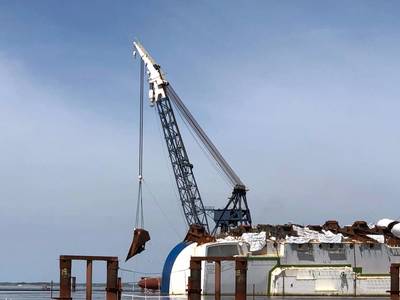Golden Ray Salvage Operations Resume
Salvage operations to remove the overturned car carrier Golden Ray from St. Simons Sound in Georgia have resumed after work was paused due to coronavirus concerns and Hurricane Isaias.
Due to the potential impact of the Hurricane to the St. Simons Sound area, the Unified Command (UC) response team implemented its Heavy Weather Plan which required the repositioning and securing of all response assets in advance of the storm’s passing.
“Our advanced planning for heavy weather paid dividends. We were prepared for Hurricane Isaias and are proud of the quick execution of our Heavy Weather Plan by our response personnel,” said Cmdr. Efren Lopez, Federal On-Scene Coordinator “There are many plans to execute and a lot of activity still going on as we prepare for the eventual cutting and lifting of the vessel itself.”
The UC says operations are underway and continuing, with cutting and lifting operations currently set for early October,
The Marshall-Islands-flagged car carrier Golden Ray has been aground on its side outside the Port of Brunswick since it capsized while en route to Baltimore on September 8, 2019. The cause of the incident is under investigation.
The ship’s pilot and 23 crew members were all recovered safely, including four crew members trapped inside the vessel for 35 hours before they could be rescued through a hole drilled into the hull.
The South-Korean-owned ship will need to be dismantled in place and removed in pieces because the vessel, in its current position and condition, is not able to support the stress exerted on the hull and keel during parbuckling operations.
A safety zone around the EPB surrounding the motor vessel Golden Ray wreck site remains in effect to protect the response crews and the public.
The VB 10,000 heavy-lift, twin-gantry crane (VB 10K), modified specifically for the cutting lifting operation, will remain in the region. VB 10K will eventually be mobilized to St. Simon’s Sound to begin cutting and lifting operations. These operations are anticipated to last for eight weeks from the onset barring any unforeseen obstacles.
Responders continue to follow CDC guidelines strictly to limit coronavirus exposure and have adapted daily operations accordingly. Measures in place include daily health checks, required wearing of face coverings, safe-distancing and teleworking (whenever possible), self-quarantines for all incoming members, continuous disinfection of facilities and work platforms, and contact tracing protocols when necessary. On-site medical advisors constantly revise health safety guidance with respect to new information about the spread of the disease.
















